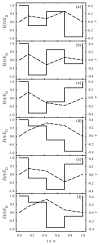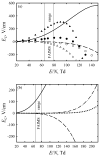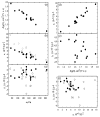Feasibility of higher-order differential ion mobility separations using new asymmetric waveforms
- PMID: 16494377
- PMCID: PMC3173260
- DOI: 10.1021/jp055349t
Feasibility of higher-order differential ion mobility separations using new asymmetric waveforms
Abstract
Technologies for separating and characterizing ions based on their transport properties in gases have been around for three decades. The early method of ion mobility spectrometry (IMS) distinguished ions by absolute mobility that depends on the collision cross section with buffer gas atoms. The more recent technique of field asymmetric waveform IMS (FAIMS) measures the difference between mobilities at high and low electric fields. Coupling IMS and FAIMS to soft ionization sources and mass spectrometry (MS) has greatly expanded their utility, enabling new applications in biomedical and nanomaterials research. Here, we show that time-dependent electric fields comprising more than two intensity levels could, in principle, effect an infinite number of distinct differential separations based on the higher-order terms of expression for ion mobility. These analyses could employ the hardware and operational procedures similar to those utilized in FAIMS. Methods up to the 4th or 5th order (where conventional IMS is 1st order and FAIMS is 2nd order) should be practical at field intensities accessible in ambient air, with still higher orders potentially achievable in insulating gases. Available experimental data suggest that higher-order separations should be largely orthogonal to each other and to FAIMS, IMS, and MS.
Figures







Similar articles
-
High-resolution differential ion mobility separations using helium-rich gases.Anal Chem. 2010 Mar 15;82(6):2456-62. doi: 10.1021/ac902852a. Anal Chem. 2010. PMID: 20151640 Free PMC article.
-
Two-dimensional ion mobility analyses of proteins and peptides.Methods Mol Biol. 2009;492:417-45. doi: 10.1007/978-1-59745-493-3_26. Methods Mol Biol. 2009. PMID: 19241049
-
Two-dimensional gas-phase separations coupled to mass spectrometry for analysis of complex mixtures.Anal Chem. 2005 Oct 1;77(19):6381-8. doi: 10.1021/ac050871x. Anal Chem. 2005. PMID: 16194103 Free PMC article.
-
High-field asymmetric waveform ion mobility spectrometry for mass spectrometry-based proteomics.Expert Rev Proteomics. 2012 Oct;9(5):505-17. doi: 10.1586/epr.12.50. Expert Rev Proteomics. 2012. PMID: 23194268 Free PMC article. Review.
-
Coupling Front-End Separations, Ion Mobility Spectrometry, and Mass Spectrometry For Enhanced Multidimensional Biological and Environmental Analyses.Annu Rev Anal Chem (Palo Alto Calif). 2017 Jun 12;10(1):71-92. doi: 10.1146/annurev-anchem-061516-045212. Epub 2017 Feb 23. Annu Rev Anal Chem (Palo Alto Calif). 2017. PMID: 28301728 Free PMC article. Review.
Cited by
-
Localization of Post-Translational Modifications in Peptide Mixtures via High-Resolution Differential Ion Mobility Separations Followed by Electron Transfer Dissociation.J Am Soc Mass Spectrom. 2016 Dec;27(12):2064-2070. doi: 10.1007/s13361-016-1498-6. Epub 2016 Sep 19. J Am Soc Mass Spectrom. 2016. PMID: 27644938 Free PMC article.
-
Predicting compensation voltage for singly-charged ions in high-field asymmetric waveform ion mobility spectrometry (FAIMS).J Am Soc Mass Spectrom. 2012 Oct;23(10):1794-8. doi: 10.1007/s13361-012-0427-6. Epub 2012 Aug 8. J Am Soc Mass Spectrom. 2012. PMID: 22872526
-
Separation and classification of lipids using differential ion mobility spectrometry.J Am Soc Mass Spectrom. 2011 Jul;22(7):1146-55. doi: 10.1007/s13361-011-0114-z. Epub 2011 Apr 12. J Am Soc Mass Spectrom. 2011. PMID: 21953096 Free PMC article.
-
High-resolution differential ion mobility separations using planar analyzers at elevated dispersion fields.Anal Chem. 2010 Sep 15;82(18):7649-55. doi: 10.1021/ac101413k. Anal Chem. 2010. PMID: 20666414 Free PMC article.
-
A high voltage asymmetric waveform generator for FAIMS.J Am Soc Mass Spectrom. 2010 Jul;21(7):1118-21. doi: 10.1016/j.jasms.2010.02.019. Epub 2010 Feb 18. J Am Soc Mass Spectrom. 2010. PMID: 20332067 Free PMC article.
References
-
- von Helden G, Wyttenbach T, Bowers MT. Int J Mass Spectrom Ion Processes. 1995;146:349.
-
- Clemmer DE, Hudgins RR, Jarrold MF. J Am Chem Soc. 1995;117:10141.
-
- Purves RW, Guevremont R. Anal Chem. 1999;71:2346. - PubMed
-
- Hoaglund CS, Valentine SJ, Sporleder CR, Reilly JP, Clemmer DE. Anal Chem. 1998;70:2236. - PubMed
-
- Asbury GR, Hill HH. J Microcolumn Sep. 2000;12:172.
Publication types
MeSH terms
Substances
Grants and funding
LinkOut - more resources
Full Text Sources
Other Literature Sources

